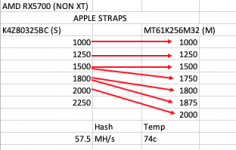Hello everyone and thank you for this gold mine of a thread!
Really a lot of very useful and interesting information here.
Your dedication to benching/testing out all these different settings and especially doing so publicly and sharing all info is greatly appreciated!
We've been following this for a while and also successfully used the parameters outlined here:
https://www.igorslab.de/community/threads/gigabyte-5700-xt-bios-mod-fails.3304/page-17#post-83096
in combination with the apple timings.
Now thank you for the recent update and the new MPT settings, we will create new modded Bios files for our cards later and try them.
I've got some questions though:
Are you suggesting of leaving the VDD and VDCCI (as well as the MVDD for Samsungs) fixed at what you wrote above and only vary only slightly in clock speed?
In the older post linked above there was a whole range of clock speeds and relating voltages. We tried out some of these and nearly all our cards run pretty stable at lower voltages than the fixed 800/850mV you wrote in today's update.
I've attached a recent screenshot to this post (yes, they're much too hot and we need to improve airflow in the rig).
Is this because if clocks are increased the chips need more power, but if you at the same time lover voltages naturally the current has to go up and higher current is heat and stress for the chip, so you are rather not undervolting too much?
I guess it also somehow relates to not exceeding the clock/voltage relation of 1.8 you mentioned so pages earlier when talking about the SoC?
Also I'd like to ask something else:
We're always modding the bios for every card using it's own stock bios as a base. For some cards this works well, but some (especially Asus Dual and XFX DD) just won't got below 130W reported in HiveOS. Now we once flashed a Sapphire Pulse with the Bios of another Pulse which reported lower and this helped very much.
So there has to be lot's of other stuff in that Bios's which we cannot alter with RBE or MPT and so we thought about using Bios's of other cards which run with nice low watts as base for modding a Bios for the Asus and XFX.
Does someone have any experiences in doing so and may be able to give any guide on how to choose a source Bios?
I read somewhere here that Fan settings/curve is important, which makes sense, as the fand are one obvious physical difference between custom cards.
Do you know of a way to transfer fan settings between Bios files, to maybe use another Bios as base for a card, but implement the fan stuff from the target cards stock?
Or are there other things which makes cross flashing Bios's between cards a rather bad idea? I've seen someone using an XFX Bios on Gigabyte cards once.
Thank you very much and best regards.




